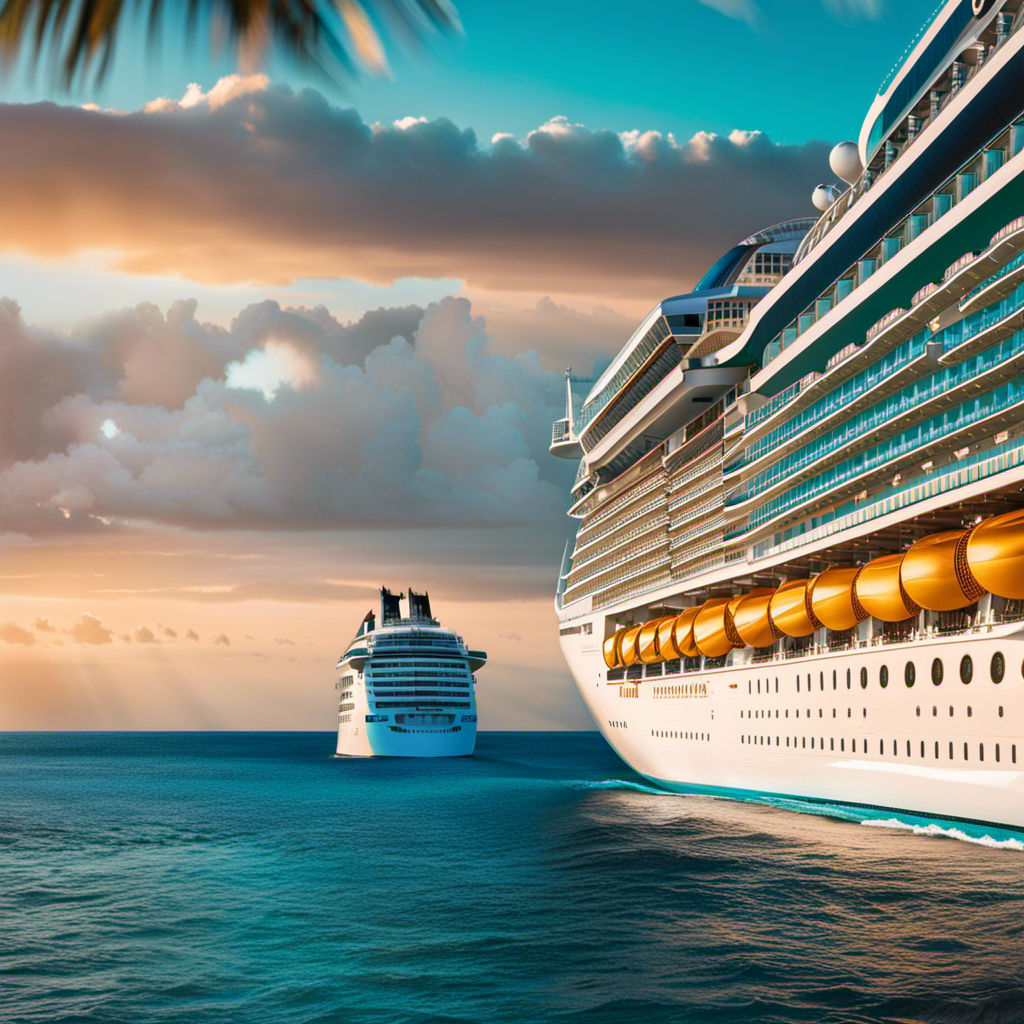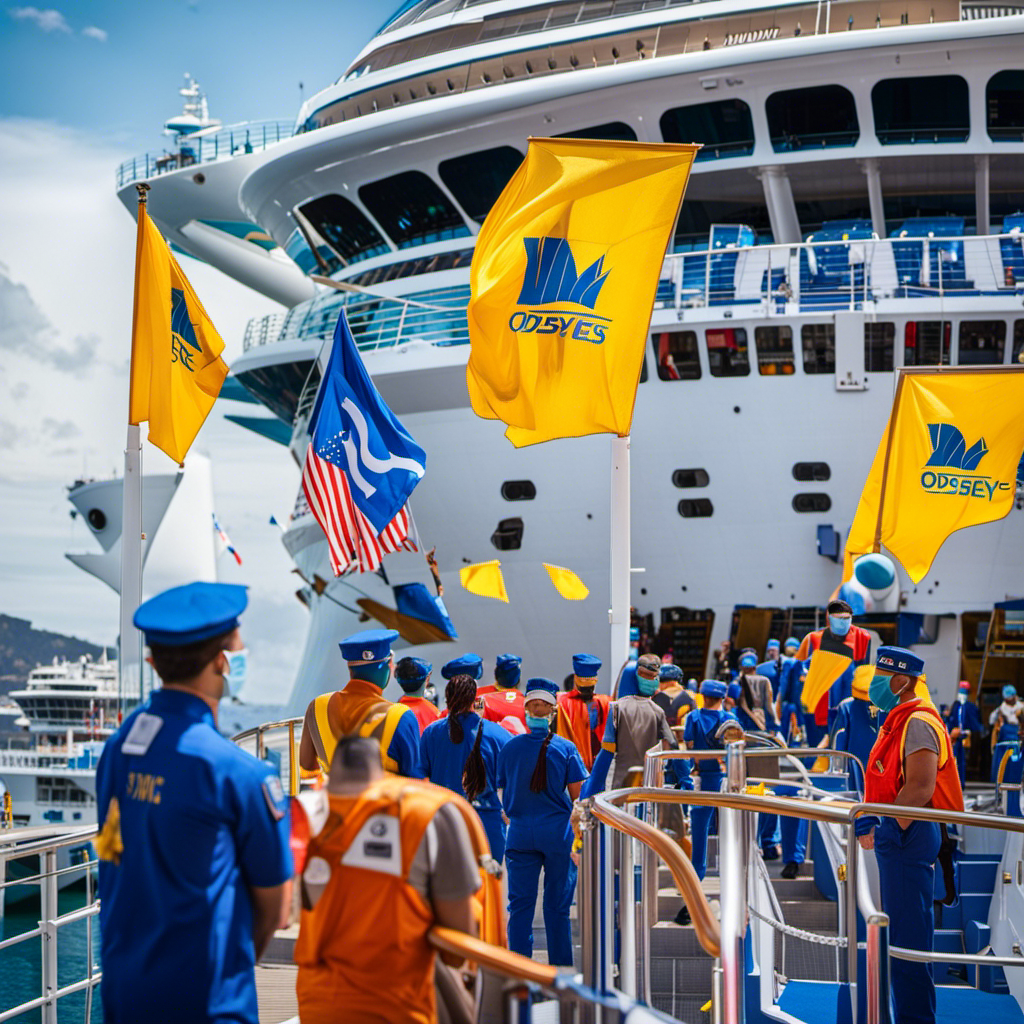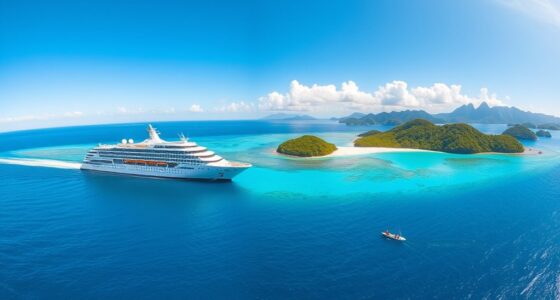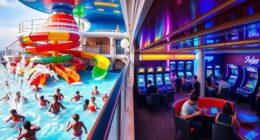I’m thrilled to share the remarkable enthusiasm surrounding the Ultimate World Cruise by Royal Caribbean, an excitement that has taken the industry by storm.
Imagine embarking on a 274-night journey that spans the entire globe, visiting over 150 destinations in 65 countries. It’s no wonder that 70% of this extraordinary voyage was booked within just seven days.
With prices starting at $61,000 per person, this cruise offers a once-in-a-lifetime experience.
Join me as we delve into the reasons behind this unprecedented demand for Royal Caribbean’s Ultimate World Cruise.
Key Takeaways
- The Ultimate World Cruise offered by Royal Caribbean has seen a high demand, with 70% of the bookings being made within seven days of its announcement.
- The starting price for an interior room for the Ultimate World Cruise was $61,000 per person, indicating that customers were willing to pay a premium for this unique experience.
- Royal Caribbean has successfully restarted its operations and has carried over 500,000 passengers since then. The company aims to carry more than one million passengers by the end of 2021.
- Despite the challenges posed by the Delta variant, Royal Caribbean remains optimistic about the future, with improved bookings, higher prices for 2022 sailings compared to 2019, and a 12% increase in revenue per passenger cruise day.
Exploring the Global Itinerary of Royal Caribbean’s Ultimate World Cruise
I can’t wait to explore the global itinerary of Royal Caribbean’s Ultimate World Cruise. It has more than 150 destinations and 65 countries. This cruise is packed with incredible highlights and unique experiences that will make it a truly unforgettable journey.
From the stunning beauty of the Greek Islands to the vibrant cultures of Asia, there is so much to see and explore. Imagine exploring the ancient ruins of Rome, snorkeling in the crystal-clear waters of the Caribbean, or witnessing the breathtaking natural wonders of New Zealand.
The Ultimate World Cruise offers a once-in-a-lifetime opportunity to immerse yourself in different cultures, sample delicious cuisines, and create memories that will last a lifetime. Whether you’re a history buff, a nature lover, or simply seeking adventure, this cruise has something for everyone.
The Phenomenal Booking Rate of the Ultimate World Cruise
Bookings for this once-in-a-lifetime journey have been incredibly fast, with 70% of the slots filled within just seven days. It’s truly remarkable to see such high demand for the Ultimate World Cruise.
As I explore customer feedback, it’s clear that travelers are drawn to the allure of visiting over 150 destinations and 65 countries. The opportunity to embark on a 274-night journey around the globe is a dream come true for many.
On top of providing an unforgettable experience for guests, the impact on local economies cannot be overlooked. With each stop along the way, the cruise brings tourism dollars to various communities. This infusion of money can have a significant positive effect on local businesses, supporting jobs and stimulating economic growth.
Additionally, the Ultimate World Cruise has the potential to showcase lesser-known destinations, putting them on the map for future travelers. The ripple effect of this kind of tourism is truly invaluable.
Unveiling the Price Range for Different Room Categories on the Ultimate World Cruise
The price range for different room categories on this extraordinary journey varies, with the starting price for an interior room at $61,000 per person and the average price of a balcony room at $75,000.
As I explored the cabin features and amenities on the ultimate world cruise, I couldn’t help but analyze customer reviews and satisfaction levels. It’s fascinating to see how these prices are reflected in the overall experience.
Many customers rave about the luxurious and spacious cabins, complete with comfortable beds and stunning views from the balconies. The amenities, such as private bathrooms, flat-screen TVs, and ample storage space, have also received high praise. It’s clear that Royal Caribbean has spared no expense in ensuring that passengers have a memorable and comfortable stay onboard.
The positive feedback and high satisfaction levels further validate the price range for the different room categories on this remarkable journey.
Royal Caribbean’s Success in Attracting Passengers for the Ultimate World Cruise
Passenger interest in the extraordinary global journey has been incredibly high, with over 70% of available spots booked within just seven days. This success can be attributed to Royal Caribbean’s marketing strategies, which effectively showcased the allure and uniqueness of the Ultimate World Cruise. By highlighting the opportunity to visit more than 150 destinations and 65 countries, Royal Caribbean captured the imagination of travelers seeking a once-in-a-lifetime experience.
Additionally, customer satisfaction with the Ultimate World Cruise has played a crucial role in its popularity. The cruise line’s commitment to providing exceptional service, luxurious accommodations, and immersive cultural experiences has garnered high praise from passengers.
The combination of effective marketing and customer satisfaction has undoubtedly contributed to the overwhelming demand for the Ultimate World Cruise, solidifying Royal Caribbean’s position as a leader in the cruise industry.
Analyzing the Return of Royal Caribbean and Its Impressive Passenger Numbers
Since resuming operations, I have been amazed by the impressive number of passengers Royal Caribbean has carried, surpassing 500,000 and aiming to reach over one million by the end of 2021.
The return of Royal Caribbean has been a significant milestone for the cruise industry, with 40 ships, making up 65% of capacity, already back in service. Despite a load factor of just 44% in the third quarter, the company has taken a thoughtful approach, prioritizing health and safety by operating at reduced capacities.
Looking ahead, Royal Caribbean is optimistic about the future and expects to bump up load factors to 65-70% in core itineraries in Q4 2021. The company aims to have 80% of its worldwide capacity back sailing by the end of the year. Bookings have improved significantly, and revenue per passenger cruise day has seen a 12% increase due to higher onboard spending.
Royal Caribbean’s popularity is undeniable, as demonstrated by the unbelievable response from loyal customers, with suites being booked within a week and non-refundable deposits being made.
The future of cruising looks bright for Royal Caribbean.
The Growth Plan: Carrying Over One Million Passengers by the End of 2021
After analyzing the impressive passenger numbers and the successful return of Royal Caribbean, it’s clear that the company has a solid growth strategy in place. Their goal is to carry over one million passengers by the end of 2021, a significant milestone. Here’s how they plan to achieve it:
-
Expanding Capacity: Royal Caribbean has already returned 40 ships, accounting for 65% of their total capacity. By gradually increasing the number of ships in operation, they can accommodate more passengers and meet the growing demand.
-
Increasing Load Factors: With the Delta variant slowdown behind us, Royal Caribbean aims to bump up their load factors to 65-70% in core itineraries for the fourth quarter of 2021. This will ensure optimal utilization of their ships and maximize passenger satisfaction.
-
Worldwide Expansion: The company plans to have 80% of their worldwide capacity back sailing by the end of the year. By offering a wide range of destinations and itineraries, Royal Caribbean can attract a diverse customer base and cater to different preferences.
With their measured approach, focus on safety measures, and commitment to passenger satisfaction, Royal Caribbean is set to achieve their growth targets and continue their success in the cruise industry.
The Strategic Approach: Returning Ships With Reduced Load Factors for Safety
I’m confident that the careful return of ships with reduced load factors is a strategic approach prioritizing safety for all passengers.
Royal Caribbean has been implementing strategies for ensuring safety as they gradually resume operations. The decision to operate with reduced load factors allows for more space and social distancing onboard, reducing the risk of transmission.
This approach has been well-received by customers, who understand the importance of prioritizing their health and well-being. By reducing the number of passengers onboard, Royal Caribbean can ensure a safer and more comfortable cruising experience.
The customer response to reduced load factors has been positive, with many appreciating the extra space and peace of mind it provides. This strategic approach demonstrates Royal Caribbean’s commitment to the safety and satisfaction of their passengers.
Optimistic Outlook: Increasing Load Factors for Core Itineraries in Q4 2021
Anticipating a positive trend, load factors for core itineraries are projected to increase to 65-70% in Q4 2021. This is a promising development for the cruise industry, considering the recent challenges posed by increased travel restrictions and the impact of COVID-19 variants.
The industry has been grappling with uncertainties and fluctuating demands due to the ever-evolving nature of the pandemic. However, as vaccination rates rise and safety protocols are firmly in place, there is growing optimism for a rebound in the cruise sector.
Royal Caribbean, in particular, aims to have 80% of worldwide capacity back sailing by the end of the year. Bookings have already shown significant improvement since the Delta variant slowdown, with 2022 sailings experiencing higher prices compared to 2019.
Despite the challenges, the cruise industry remains resilient and is adapting to the changing landscape to ensure a safe and enjoyable experience for passengers.
Royal Caribbean’s Ambitious Goal: 80% Worldwide Capacity by Year’s End
Achieving 80% worldwide capacity by the end of the year is an ambitious goal for the cruise industry. Royal Caribbean’s capacity plans aim to have 80% of their worldwide capacity back sailing by the end of the year.
However, there are challenges in achieving this target. The ongoing COVID-19 pandemic, with the emergence of the Delta variant, has disrupted the industry’s recovery. Reduced load factors and a careful return to operations have been necessary for the health and safety of passengers and crew. Additionally, there may be logistical hurdles in terms of port availability, crew recruitment, and ensuring compliance with evolving health and safety protocols.
Despite these challenges, Royal Caribbean remains optimistic and has seen improved bookings since the Delta variant slowdown. They are taking a measured approach, slowly building their operations back up, and demonstrating the safety and simplicity of cruising to regain passenger confidence.
The Future of Cruising: Strong Bookings and Higher Prices for 2022 Sailings
Bookings for 2022 sailings are showing strong demand and higher prices compared to 2019, indicating a positive future for the cruising industry. Despite the impact of the Delta variant, there is optimism for the future of cruising.
Here are some key trends and insights:
- Bookings have improved significantly since the Delta variant slowdown.
- 2022 sailings are within historical ranges and at higher prices compared to 2019.
- Revenue per passenger cruise day is up 12% due to higher onboard spending.
- Trips further out on the calendar are experiencing more normal booking measures.
These trends suggest that travelers are eager to get back on board and explore the world. The cruising industry is taking a measured approach, implementing safety measures to ensure the health and well-being of passengers.
As the Delta cases fall in the United States, the future of cruising looks promising, with strong bookings and a positive outlook for 2022 sailings.
Frequently Asked Questions
What Safety Measures Has Royal Caribbean Implemented to Ensure the Health and Safety of Passengers on the Ultimate World Cruise?
Safety protocols and passenger well-being are paramount on the Ultimate World Cruise. With comprehensive measures in place, Royal Caribbean ensures a safe and enjoyable experience for all passengers, prioritizing health and peace of mind.
How Has the Delta Variant Slowdown Affected Bookings for the Ultimate World Cruise?
The Delta variant slowdown initially impacted bookings for the Ultimate World Cruise, with travel restrictions and uncertainty deterring some passengers. However, as the situation improves, bookings have started to rebound, indicating a positive outlook for the future.
What Is the Average Price Range for Different Room Categories on the Ultimate World Cruise?
The average price range for different room categories on the Ultimate World Cruise varies. From interior rooms starting at $61,000 per person to balcony rooms averaging around $75,000. Safety measures and health are prioritized for passengers.
How Does Royal Caribbean Plan to Increase Load Factors for Core Itineraries in Q4 2021?
To increase load factors for core itineraries in Q4 2021, Royal Caribbean plans to implement effective marketing strategies. However, potential challenges may arise due to factors such as ongoing travel restrictions and cautious consumer behavior.
What Are Some of the Reasons for the Unprecedented Demand and Popularity of Royal Caribbean’s Ultimate World Cruise?
The reasons for the unprecedented demand and popularity of Royal Caribbean’s Ultimate World Cruise are its global itinerary, the allure of visiting numerous destinations, and the luxury experience it offers. Safety measures implemented by Royal Caribbean have also contributed to its appeal.
Claire, a creative soul with an unquenchable thirst for storytelling, is an integral part of the Voyager Info team. As a dedicated writer, she weaves captivating narratives that transport readers to enchanting cruise destinations and beyond.
Claire’s love affair with writing began at an early age when she discovered the magic of words and their ability to craft worlds and emotions. Her innate curiosity led her to explore various literary genres, but it was travel writing that truly captured her heart. Drawing inspiration from her own globetrotting adventures and encounters with diverse cultures, Claire embarked on a journey to become a travel writer par excellence.











